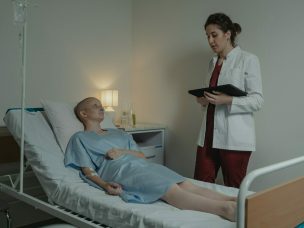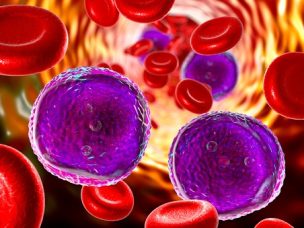Leukemia
Safety and Efficacy of Venetoclax and Selinexor with Chemotherapy
The combination of venetoclax and selinexor alongside chemotherapy was well-tolerated in patients with relapsed or refractory acute myeloid leukemia in a recent data analysis of a phase 1 study. Children and adolescents/young adults with relapsed or refractory acute myeloid leukemia (R/R AML) continue to have poor survival rates. In children with R/R AML, prior clinical...
Venetoclax/Azacitidine/Selinexor Combination Therapy for Unfit Acute Myeloid Leukemia
Selinexor in combination with venetoclax and azacitidine (the SAV regimen) is safe and effective, with encouraging complete response rates, according to a recent prospective study. Acute myeloid leukemia (AML) primarily affects older people, who are frequently unable to endure intense chemotherapy due to frailty or comorbid conditions. While venetoclax with azacytidine has a 64% response...
Long-Term Effects of Cranial Radiotherapy in Pediatric Leukemia and Lymphoma Survivors
Significant metabolic and endocrine disturbances have been found in survivors of childhood-onset acute lymphoblastic leukemia or aggressive non-Hodgkin’s lymphoma treated with cranial radiotherapy. A recent meta-analysis emphasizes monitoring for potential long-term complications in these patients. Childhood-onset and cranial radiotherapy-treated acute lymphoblastic leukemia or aggressive non-Hodgkin’s lymphoma survivors are more likely to have reduced height, precocious...
Racial Differences in Hospitalization Outcomes for Plasma Cell Leukemia
No significant differences were found in plasma cell leukemia outcomes among racial groups of hospitalized patients in a recent study. Plasma cell leukemia (PCL) is an aggressive subtype of multiple myeloma (MM) with a poor prognosis. Prior studies have documented racial disparities among MM patients regarding prevalence, treatment outcomes, and mortality, but limited data exists...
Carrot Intake and Risk of Developing Cancer
Consistent consumption of raw carrots is associated with protection against lung cancer, leukemia, pancreatic cancer, and large bowel cancer. Various cohort studies have demonstrated the role of consistent consumption of fruits and vegetables in reducing the risk of various types of cancer. Carrots are a major source of falcarinols, which have been shown to inhibit...
B-ALL Survival Affected by Socioeconomic Status
Staff Writer: Deileta Kamhunga The survival rates of B-cell acute lymphoblastic leukemia (B-ALL) have been dramatically improved through relatively new therapies. One such therapy is CD19-directed chimeric antigen receptor T-cell (CART) therapy, which has improved survival rates, particularly in children with relapsed or refractory B-ALL. However, other external factors may also have a significant impact...
Diagnosing Chronic Lymphocytic Leukemia (CLL)
Chronic lymphocytic leukemia (CLL) is a cancer that occurs when the bone marrow makes too many lymphocytes, a type of white blood cell. CLL usually grows slowly compared to other leukemias, and it may not cause symptoms for some time. CLL is one of four main types of leukemia. It is the second most common...
Research Sheds Light on Ethnic Discrepancies in CLL
Chronic lymphocytic leukemia (CLL) is the most common form of leukemia in the United States. In fact, it is often considered a disease primarily isolated to the Western world. There are remarkable patterns in the incidence of the disease among ethnicities. It most commonly appears in Caucasian individuals and markedly less so in non-Caucasians. For...
More Medical News













